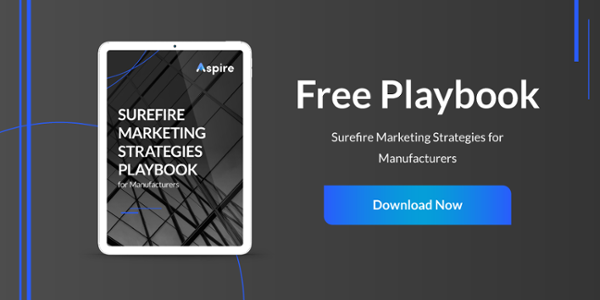- Marketing Strategy
- Manufacturing
- August 24, 2022
6 Biggest Marketing Mistakes B2B Manufacturers Make

Aaron Marks

Manufacturers occupy an interesting position in the B2B supply chain. Manufacturers of higher-tech and higher-ticket items in particular face unique challenges: they sell to exacting, demanding buyers. In the past, simply having a great product was often enough to gain traction and grow.
But today, rapid demographic changes have turned manufacturing sales on its head. Modern buyers prefer to do 67% of their research on their own, digitally. The way they choose vendors and products is totally disrupted by the internet. And thanks to companies like Amazon, buyers expect a comparable online experience from everyone they do business with – even when it’s a small-to-midsize company.
Having spent many years leading marketing in-house for manufacturers, and now serving as a consultant and agency for them, I’ve seen a number of common mistakes that manufacturers make in their marketing. Many of these mistakes can be a deathblow to sales and revenue growth.
In this article, I’ll identify the six most common mistakes that B2B manufacturers make, discuss why they’re so damaging, and explain how to avoid them.
1. Focusing all the marketing on the product.
As a manufacturer, you ultimately sell one or more products – so it makes sense to focus on promoting and selling those products in your marketing. Right?
Not exactly. Yes, manufacturers need to be able to explain, specify, and ultimately sell their products. But very few buyers go out looking for a specific product. Buyers start with a problem, and research that problem – and only after they’ve done that, do they then begin to consider and specify specific products.
One of the biggest mistakes I’ve seen is a manufacturer that focuses all their manufacturing on creating things like data sheets, brochures, and catalogs. This is great for enabling the 5% of buyers who are ready to buy today. But by neglecting the other 95%, you’re setting your business up to miss out on a HUGE part of your market.
Buyers aren’t ready to talk about your product until they’re 1) far down the funnel from doing their own research, and 2) in-market and ready to buy.
Let me give you two concrete examples from my real-world experience.
Aquion Energy – Manufacturing an Advanced Battery for Energy Storage
Aquion Energy was a rapidly commercializing manufacturer, whose lead investor was Bill Gates. We were commercializing a new solution in a not-so-new market: a battery that used new technology to be fully renewable and clean.
But here’s the problem: buyers don’t typically go looking for fancy new technology. They begin their research trying to solve a problem, and only then do they narrow into technology.
In our case, these batteries were designed for storing solar energy that is generated by day, so that there would be power at night, when the sun wasn’t out.
Our customers would often begin their research journey by researching things like “storing solar energy” or “energy storage.” They had become aware that they had a problem (solar power only works when the sun is out), and were searching for solutions. At this moment, if we tried to reach them with spec sheets or brochures, we would have lost the business. They weren’t ready for product materials, they wanted to be educated on the problem and its possible solutions. Offering things like data sheets and brochures would have been misaligned – and not helpful – potentially losing us the business.
That’s why we created one of the industry’s most active blogs, full of educational and helpful content. We became a trusted source for buyers doing research, and in doing so, generated 4x the leads from when we started.
Nord-Lock – A Manufacturer of High-End Bolting Solutions
Nord-Lock was a world leader in bolting technologies, and it had created an industry-leading fastener that prevented bolts from vibrating loose. Bolt loosening is a massive problem in engineering, with huge costs financially and in terms of safety.
Many engineers already knew the name, but we were struggling to reach and sell to those who didn’t know about us. The company had amazing brochures and sales collateral, but when an engineer experienced bolt loosening, they needed to do a lot of research before that information would prove helpful.
As they began to become aware of the problem, a buyer might ask, “Why do bolts loosen?” or “How do I keep bolts from loosening?” Again, a brochure or catalog wouldn’t help them solve this problem.
Instead, we began creating content to help educate them that wasn’t at all about our product. We created a detailed eBook called, “Why Do Bolts Loosen,” which explained in technical terms why bolts come loose – and offered a look at all the different solutions available, including ours.
By being helpful and educational, and not talking at all about ourselves or our product, we were able to help buyers with an initial problem. And by earning their trust early, they would then think about us when they were ready to buy a product.
2. Choosing Outbound Marketing All the Way
“Outbound marketing is a traditional method of marketing seeking to push messaging out to potential customers. It is costly and the ROI is much lower than inbound marketing.”
Manufacturers may experience this trap more than any other industry I’ve worked with. If you’re not familiar, outbound marketing describes “the traditional method of marketing seeking to push messaging out to potential customers.” Think, trade shows, advertising, and cold calling. Meanwhile, inbound marketing “attracts customers by creating valuable content and experiences tailored to them.”
When most manufacturing leaders think about marketing, their mind immediately goes to trade shows, events, and advertising. The problem is, people have learned to tune out ads and other intrusive forms of marketing better than ever today. And while ads can work, they need to be “the right message at the right place at the right time.” And simply running product ads when, as mentioned earlier, only 5% of your buyers are looking for your product, is a surefire way to get tuned out and not get a return on those ads.
Inbound marketing is all about building trust. And when you help your buyers do all of their research with inbound marketing, that trust will pay dividends because they’ll often choose to buy from you instead of a competitor.
3. Investing in Sales but Not Marketing
Sales is important to growing every organization, but manufacturers often overlook marketing and instead invest heavily into sales. If you fall into this camp, you might want to reconsider.
Buyers these days typically need to do loads of research before they want to talk to sales. In fact, according to extensive research from Forrester, 67% of B2B research today is done digitally – and without the help of sales. Buyers are intentionally choosing to use the internet to conduct research themselves.
And if you want to be in a buyer’s consideration set after that research, you need to ensure that your company turns up during their research phase. Building awareness of your company, and offering helpful and educational content so that people choose to buy from you, is a key reason to invest in marketing. If your brand isn’t one that comes to mind when your buyers are ready to buy after this research process, then the business will end up going to the competitor that did come to mind.
4. Not Being Self-Service Throughout the Buyer’s Journey
A new generation is increasingly taking over the reigns of decision making. In the past, sales and relationships were the key to closed deals and revenue growth. Today, those things have become less important, with buyers preferring self-service online experiences instead.
This trend has been fueled by the likes of Amazon, who have trained people that they can research and buy what they want on demand on their desktop por phone, get great customer service, and have it delivered in 2 days or less.
In fact, nearly a decade ago, Forrester predicted that self-service eCommerce would displace 1 million US salespeople. That trend has only accelerated into the 2020s.
This desire for self-service online solutions has expanded to fill the entire buyer’s journey. Whether your buyer is doing research or is ready to buy today, they expect your company to deliver an Amazon-like experience from start to finish. If you don’t, they’ll be more likely than ever to take their business elsewhere.
Does your manufacturing company meet these new buyer expectations?
5. Not Using a CRM
A CRM like HubSpot is truly essential to the growth of manufacturers, yet they are among the companies least likely to use them. There are a few reasons why it’s so important.
First, it’s crucial to have a central place to track your sales and marketing efforts. One of the worst phenomenon I’ve seen in manufacturing is that when a salesperson turns over, they just take their book of business with them! This is fully preventable simply by having the entire sales team track their leads and opportunities in a centralized CRM.
Plus, CRM allows you to truly track and measure the results of your investments. If you’re spending money on ads and tradeshows, but you’re not sure if they’re paying off, a CRM is the missing piece of the puzzle.
6. Being Tactical/Reactive Instead of Strategic
One of the toughest calls I take these days is when someone asks, “Can you take over my email marketing?” or “Can you help me get more LinkedIn followers?”
In marketing, sending emails, posting on LinkedIn, or creating blog posts are things that we call tactics. And I can’t tell you how many manufacturers I’ve seen that latch onto one of these tactics because they see their competitors doing it, or because it’s the topic du jour of the day – and then see it fail miserably.
Manufacturers should only execute tactics that support a larger strategy, and that strategy should be linked to business objectives.
It’s one thing to say, “Let’s send more email to our customers.”
It’s another to say, “We have a business objective to increase repeat business by 30%. To help support that, let’s use a tactic that involves sending a monthly list of promotions and sales to our existing customers.”
Having been in this business for nearly two decades, there’s one thing that has held consistently true: Tactics that are done without a clear purpose, as part of a bigger picture strategy, will inevitably fail.
Avoid These Mistakes to Grow Your Manufacturing Business
One of the most exciting parts of marketing as a manufacturer is that the industry overall tends to be well-behind the curve with marketing trends and practices. You don’t need to reinvent the wheel to grow your B2B manufacturing company through marketing. You simply need to learn what’s worked in other industries, and then adapt it appropriately to your business.
The overall theme here is all about having an amazing customer-focused experience. Customers expectations and needs have evolved over the last decade, and to win in this environment, you need to evolve, too.
By building a robust buyer’s journey that is helpful from when your customers start to do research until they are ready to buy, you can outmuscle your competitors and grow your manufacturing business.
Aaron Marks is the Chief Marketing Officer of Execo. A digital pioneer with nearly two decades of online marketing experience, Aaron has helped organizations ranging from fledgling startups to Fortune 500 enterprises, and global manufacturers to U.S. Presidential campaigns, get the marketing and business results they needed.



0 Comments